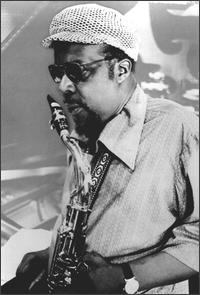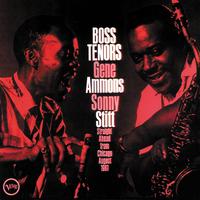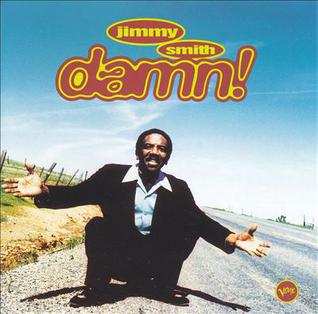One Before This – Gene Ammons
This is an "It doesn't have to be hard to be good" classic. Check out the recordings: everyone is having a whole lot of fun. A simple, swinging riff song with rhythmic hits played by the whole band. Condensed scores and various parts are available for both two-horn and three-horn arrangements. The lead sheets are the 1st parts.
- Recording: Gene Ammons - Boss Tenors
- Recorded on: August 27, 1961
- Label: Verve (V-8426)
- Concert Key: F
- Vocal Range: , to
- Style: Swing (medium)
- Tenor Sax - Gene Ammons, Sonny Stitt
- Piano - John Houston
- Bass - Buster Williams
- Drums - George Brown
Video
- Description
- Historical Notes
- Solos
- Piano Corner
- Bass Corner
- Drum Corner
- Guitar Corner
- Inside & Beyond
- Minus You
Because there are so many chords in the A section riff, our lead sheets and parts show chord symbols for only the first two and last two measures of A, the bridge, and the last two measures of C. Rhythm section players should use the Concert Condensed Score which shows the original bass hits, etc.
About the arrangement: Our lead sheets work as a first part for both the quintet and sextet arrangements. In the quintet arrangement, the second part harmonizes the A section melody riff with a chromatic “walk up” with the changes, a third above the roots. The bridge riff is harmonized mostly in whole steps. The quintet Concert Condensed Score shows in detail how this song is played on the original Ammons/Stitt recording. In each measure of the A section riff, the bass fills in around the melody with alternating low and high C on the “and” of beat 3. Other important bass notes are shown in the condensed score; notably, on this recording the bass notes of the riff are a third below the roots of the piano chords (E♭, E, F). The ending in this score also reflects the recording: the last note is held out and the rhythm section plays a final F7(♯9♯11) chord. This song could easily end more abruptly, as in the Jimmy Smith recording (see album cover above, right); this is shown in our lead sheets and parts.
If you are in a 2-Tenor quintet, and you want to play it exactly like Ammons and Stitt, you'll each have to mark your parts accordingly: Ammons plays the top parts at A and C except at the end of the 7th measure of the first A. Stitt plays the melody on the bridge.
Don Sickler: Not that long ago, when two great baritone saxophonists (Gary Smulyan and Frank Basile) surprised me by having some serious fun rehearsing The One Before This in my rehearsal studio, I knew I had to put it on the top of my Gene Ammons list to put up on jazzleadsheets.com. This music needs to be played!
Related Songs
Email Send One Before This to a friend
- Recording: Jimmy Smith - damn!
- Recorded on: January 24, 1995
- Label: Verve (314-527631)
- Concert Key: F
- Vocal Range: , to
- Style: Swing (medium)
- Tenor Sax - Ron Blake, Mark Turner, Tim Warfield
- Organ - Jimmy Smith
- Guitar - Mark Whitfield
- Bass - Christian McBride
- Drums - Art Taylor
Video
- Jimmy Smith at the organ, Montreux 1996. Don Sickler: It always makes an arranger/producer feel good when an artist takes one of his new recording session arrangements on the road and continues to perform it. At this Montreux performance, Jimmy had only two horns, and, although he wasn't on our 3-horn track, which was a three-tenor feature, trumpeter Nicholas Payton was on several of the other tracks on the "Damn!" project. The tenor soloist at the Montreux concert is incorrectly listed as Ron Blake on YouTube, but it's actually Tim Warfield, who was one of the other great tenor players on our session. Maybe someday the whole performance will show up on YouTube.
- Description
- Historical Notes
- Solos
- Piano Corner
- Bass Corner
- Drum Corner
- Guitar Corner
- Inside & Beyond
- Minus You
Don Sickler: In the original 2-horn arrangement, the pianist comped all of the chords to fill in the voicings. The bass was in charge of the syncopations that ended each phrase of the A section melody. The new instrumentation of organ and three horns let me think about it differently. Our bassist, Christian McBride, knew the original recording, but was fine with me putting him on the bottom of the horn section, letting Jimmy fill all of the breaks. I remember telling Jimmy, "My idea was to give the horns and the bass all the melody figures, and you get to explore all of the breaks, and whatever else you want." Jimmy took advantage of the great sustaining ability of the organ, holding his opening notes right through the horns' punctuating chords. I loved that effect!
Our sextet Concert Condensed Score again shows all the important rhythm section activity on the head on this recording, including Jimmy's opening organ fills.
Don Sickler: Jimmy was very easy to work with at this session. When drummer Art Taylor arrived, Jimmy and the rest of us were concerned about Art because he looked very frail. I remember Art saying to me that he was sure he would be cool for one take of everything, but he wasn't in shape for any rehearsing. I had been taking to Art on the phone before the session, and he sounded like the Art I had known for years, always articulate and together. When he showed up at the session, we were all in shock at his physical appearance. Listening to his performances, however, you hear nothing but his usual great drumming—no problems at all!." Art's determination and drive really inspired Jimmy and everyone else there.
Jimmy Smith recorded a lot of classic albums for Verve Records in the 1960s and 1970s, including, in 1966, "The Dynamic Duo" album with guitarist Wes Montgomery which also featured the classic Down By The Riverside, arranged and conducted by Oliver Nelson and recorded at the Van Gelder Recording Studio. In 1994, I was honored to be the conductor for Jimmy Smith and guitarist Kenny Burrell's re-enactment of that classic recording on the stage of Carnegie Hall.
That concert started Jimmy's return to Verve, and I was added to the list of Jimmy Smmith producers and arrangers with the "Damn!" and "Angel Eyes" albums. I had been involved with Jimmy before, when he returned to his original record company, Blue Note, for the "One Night With Blue Note" video and recording project (1985). That's when I learned the hard way NOT to give Jimmy any music to read! I'll save the gory details of that story for another time. I next worked with Jimmy at the Mt. Fuji Jazz Festivals in the late 1980s. In 1990 I got to play behind him in the trumpet section of the Blue Note Big Band, on another one of our jazzleadsheets.com classics: Moanin' by Bobby Timmons. This video shows the full, true, wild-man, crowd-pleasing character of Jimmy Smith. He hadn't heard my arrangement before, and my orchestrated transcription of Bobby Timmons solo surprised him. As you'll see, Jimmy always has fun! As tough as he could be to work with at times, once you got him playing, his magical organ voice would always take you over.
Related Songs
Email Send One Before This to a friend

Gene Ammons
April 14, 1925 – July 23, 1974
Gene Ammons is the son of the great boogie-woogie pianist Albert Ammons. Born in Chicago, Gene studied music at Du Sable High School under Captain Walter Dyett. He left Chicago at 18 to tour with King Kolax. On September 5, 1944, at the age of 19, he made his first recording with Billy Eckstine and his Orchestra. The Eckstein band was truly legendary, with Dexter Gordon on tenor sax, Leo Parker on baritone, Dizzy Gillespie in the trumpet section, Art Blakey on drums, Tommy Potter on bass, Sarah Vaughan singing with the band, and Tadd Dameron as one of the arrangers. It was a hothouse of talent and creativity and an immense opportunity for the young Gene, whom Billy nicknamed “Jug” when the straw hats ordered for the band were too small for his head. Read more...




